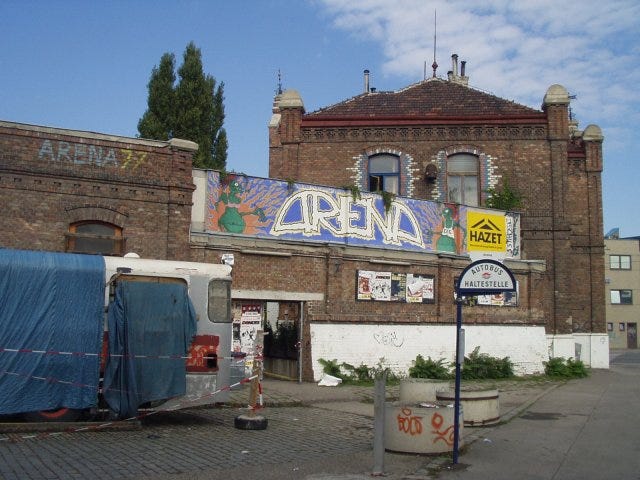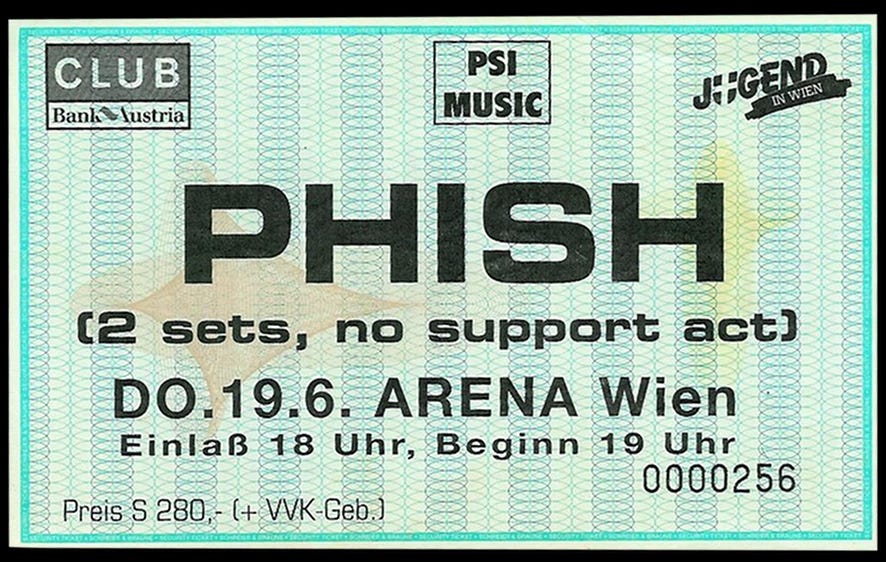SET 1: Limb By Limb, Dogs Stole Things, Theme From the Bottom > Punch You in the Eye, Water in the Sky, Maze, Waste, Vultures, Runaway Jim
SET 2: Stash -> Ghost -> Saw It Again > Wading in the Velvet Sea, Piper, Jesus Just Left Chicago > Prince Caspian
ENCORE: Beauty of My Dreams > Character Zero, Hello My Baby
Sea changes in Phish’s sound are often fueled by new material, but also, more prosaically, by tweaks to the band’s gear. It’s not entirely coincidence that I started this project (over a decade ago!) with 2/3/93, the first show where Page brought a baby grand piano on the road, a symbolic transition from bar band/get-in-the-van origins to professional touring operation capable of piano-hauling logistics. Throughout the mid-nineties, the band slowly added tech to a stage setup that still wasn’t that far off from their Nectar’s days, even as the rooms got much larger. Each new toy nudged the band in a new direction: Trey’s digital delay loop pedal in 1994, Page’s synthesizer and clavinet in 1994, and Trey’s mini percussion kit in 1995.
A contributor to the malaise of 1996 may have been the lack of new additions of this ilk. The biggest gear investment was likely the acoustic setup — an upright piano, acoustic guitar and bass, and smaller trap kit that could be wheeled out when the band felt like cranking the volume down. Page’s theremin showed promise, but came and went without ever seeing use outside of brief solo demonstrations. Instead of altering their instruments, Phish sought inspiration in swapping them, first through rotation jams and then, in early 1997, writing songs that placed everyone in an unfamiliar position.
But the end of that winter European run brought one of the most significant equipment upgrades in Phish history: Mike switching to the Modulus bass on 3/1/97 and immediately unlocking the new sound they had been chasing for at least a year. When they returned home to the States, they woodshedded in Bearsville for a while on improvised sonic experiments, which apparently led to further refinements to their stage gear. Back in Europe, there’s a buffet of new sounds to feast upon — some additions, some subtractions, and some reassessments of tools that have been underutilized to this point.
First, a key subtraction. Longtime followers know how Trey’s mini-kit has tormented me over the last year-plus. I tried to give it a chance, I really, really did. But while its intentions were pure — removing Trey from his native instrument and forcing the other three to step up — its execution was poor, repeatedly diverting promising jams into creative cul de sacs. So it is with great pleasure that I note that, in June of 1997, the mini-kit is officially dead. Four shows in, I have yet to hear its distinctive “boom-tick” in a jam, and in the scant photos I’ve found of these early dates, the side of Page’s piano is blessedly clear of percussive instruments. Hallelujah!
The loss of the mini-kit crutch forces Trey to be more creative in how he spends jams, and to do so, he turns back to some old friends on the pedal board. Most significant for the cowfunk era, of course, is the wah pedal, which has immediately become the bat signal for the band to shift into its new improvisational channel, in any song, at any time. Tonight, it happens in a truly excellent Stash, which abruptly decides 15 minutes into its 21-½ to shift from anxiety nightmare to dance party.
But there’s another pedal that finds a second, more productive life on this tour: Trey’s digital delay. In 1994 and 1995, the “DDL Jam” usually designated a special show, but it was also a closed-circuit feature — usually Trey, alone, stacking bubbling riffs over himself in a psychedelic collage. In 1997, he’s learning to deploy loops more subtly and in a full-band context, adding texture and depth. He hasn’t started adding that whirling, piercing howl to Ghost yet, but a similar usage occurs in tonight’s Caspian, where Trey samples a high, sustaining note (listen at 8:00) and keeps it running in the background as he continues his solo. It’s an approach he’ll develop for the rest of the decade, until 1999 and 2000 jams will often feature multiple, simultaneous loops creating a Wall of Treys.
A second pedal innovation happens to Trey’s left. In addition to his new bass guitar and his move to mostly using a pick, Mike has also either added or leaned in hard on a synth-bass sound, liberally deployed tonight in the Stash > Ghost > Saw It Again centerpiece. Again, I’m no gear guy, but a little internet detective work suggest it might be the Boss SYB-3 Bass Synthesizer, which ”can turn any electric bass guitar into a dance, techno, hip-hop, funk or R&B machine,” according to the PR.
Mike turns it on around 16:30 in response to Trey’s move to the wah in Stash, just before they move through a brief Cities tease and what sounds like a very early Black-Eyed Katy/Moma Dance. And he hops on and off of it for most the next 20 minutes, complementing his shift to playing more minimally, adding a sci-fi sheen to each note. It’s as much a part of the “1997 sound” as Trey’s wah and Page’s clavinet, an essential component of its Mothership motor. The band’s still puzzling out what it wants to do in the Ghost jam — tonight it sounds like it’s repeatedly detuning — but Mike’s new spacey tones will help it find its way.
Finally, there’s Page’s Hohner clavinet, which does more than any other instrument to define the sound of Ghost and, by relation, 1997. The clav has been in Page’s rig for at least a couple years (Ryan Storm identified it as early as Fall 1994) but it was rarely touched. Now it’s appearing on a nightly basis; it contributes to tonight’s detuning jam, pitch-shifting notes down, down, down. As Page himself says, it works “not unlike a guitar,” an effect magnified by running it through wah and phase-shifter pedals. It creates an intriguing sonic turf battle, elbowing into Trey’s territory, doubling up the layers of rhythmic strumming, shifting the melodic controls to Mike.
What all these changes share in common is the ability to make more with less, with pedals picking up from the initial note or chord and smearing out a prolonged, textured sound. The fresh gear perfectly complements the band’s minimalist ambitions, keeping the sonics large and deep even as they pull back on the actual playing and give jams more room to breathe. In isolation, each of these gear changes may have left a subtle footprint, but in combination, they launch Phish evolution into overdrive.






My ninth Phish show, and first since Pauley Pavilion the previous year (Say that three times at 45rpm). My first in Europe and really a great callback to my first four theater and club shows from 91/92. Small crowd, small punk rock compound with both indoor & outdoor stages.
First impression is woah, these guys are amazing to watch up close. Second was this is different act than eight months earlier. It was clear they were going somewhere else, they were evolving.
This show will always be memorable for me because before the show a guy walked up to me and said, "Hi, remember me?" And I replied, "No." and he said, "Remember that Greyhound Bus ride from Chicago to Oakland to catch the 1990-91 NYE Grateful Dead shows we took together?"
Now nearly seven tears later and in Vienna, Austria we met again. I was flabbergasted. It felt like I had met a ghost. Never saw him again after this show. And of course this show was my first ever Ghost.
Shoot it felt like half the show was first time songs for me and I loved it.
Excellent observations my dude.